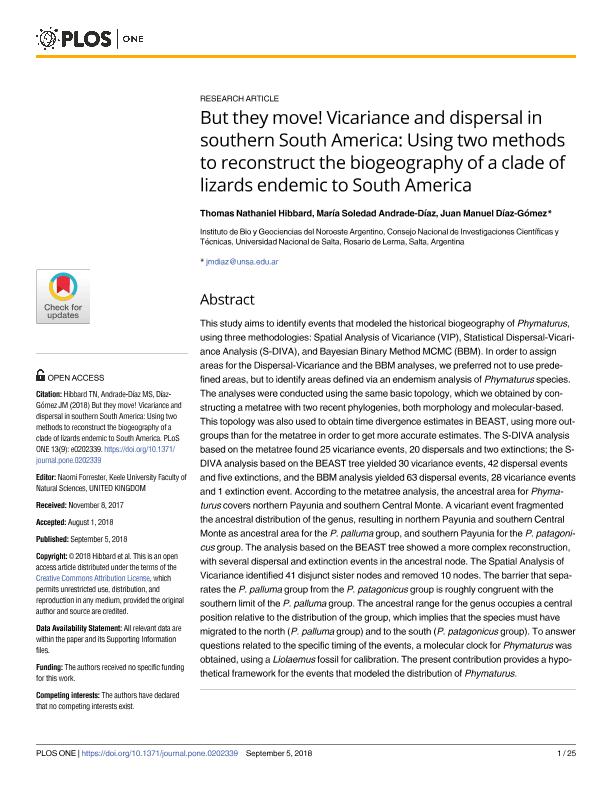Mostrar el registro sencillo del ítem
dc.contributor.author
Hibbard, Thomas Nathaniel

dc.contributor.author
Andrade Díaz, Soledad María

dc.contributor.author
Diaz Gomez, Juan Manuel

dc.date.available
2020-10-23T18:51:55Z
dc.date.issued
2018-09
dc.identifier.citation
Hibbard, Thomas Nathaniel; Andrade Díaz, Soledad María; Diaz Gomez, Juan Manuel; But they move! Vicariance and dispersal in southern South America: Using two methods to reconstruct the biogeography of a clade of lizards endemic to South America; Public Library of Science; Plos One; 13; 9; 9-2018; 1-25
dc.identifier.issn
1932-6203
dc.identifier.uri
http://hdl.handle.net/11336/116758
dc.description.abstract
This study aims to identify events that modeled the historical biogeography of Phymaturus, using three methodologies: Spatial Analysis of Vicariance (VIP), Statistical Dispersal-Vicariance Analysis (S-DIVA), and Bayesian Binary Method MCMC (BBM). In order to assign areas for the Dispersal-Vicariance and the BBM analyses, we preferred not to use predefined areas, but to identify areas defined via an endemism analysis of Phymaturus species. The analyses were conducted using the same basic topology, which we obtained by constructing a metatree with two recent phylogenies, both morphology and molecular-based. This topology was also used to obtain time divergence estimates in BEAST, using more outgroups than for the metatree in order to get more accurate estimates. The S-DIVA analysis based on the metatree found 25 vicariance events, 20 dispersals and two extinctions; the SDIVA analysis based on the BEAST tree yielded 30 vicariance events, 42 dispersal events and five extinctions, and the BBM analysis yielded 63 dispersal events, 28 vicariance events and 1 extinction event. According to the metatree analysis, the ancestral area for Phymaturus covers northern Payunia and southern Central Monte. A vicariant event fragmented the ancestral distribution of the genus, resulting in northern Payunia and southern Central Monte as ancestral area for the P. palluma group, and southern Payunia for the P. patagonicus group. The analysis based on the BEAST tree showed a more complex reconstruction, with several dispersal and extinction events in the ancestral node. The Spatial Analysis of Vicariance identified 41 disjunct sister nodes and removed 10 nodes. The barrier that separates the P. palluma group from the P. patagonicus group is roughly congruent with the southern limit of the P. palluma group. The ancestral range for the genus occupies a central position relative to the distribution of the group, which implies that the species must have migrated to the north (P. palluma group) and to the south (P. patagonicus group). To answer questions related to the specific timing of the events, a molecular clock for Phymaturus was obtained, using a Liolaemus fossil for calibration. The present contribution provides a hypothetical framework for the events that modeled the distribution of Phymaturus.
dc.format
application/pdf
dc.language.iso
eng
dc.publisher
Public Library of Science

dc.rights
info:eu-repo/semantics/openAccess
dc.rights.uri
https://creativecommons.org/licenses/by-nc-sa/2.5/ar/
dc.subject
Vicarianza
dc.subject
Dispersión
dc.subject
Lagartijas
dc.subject
Sudamérica
dc.subject.classification
Biología

dc.subject.classification
Ciencias Biológicas

dc.subject.classification
CIENCIAS NATURALES Y EXACTAS

dc.title
But they move! Vicariance and dispersal in southern South America: Using two methods to reconstruct the biogeography of a clade of lizards endemic to South America
dc.type
info:eu-repo/semantics/article
dc.type
info:ar-repo/semantics/artículo
dc.type
info:eu-repo/semantics/publishedVersion
dc.date.updated
2019-10-18T18:11:49Z
dc.journal.volume
13
dc.journal.number
9
dc.journal.pagination
1-25
dc.journal.pais
Estados Unidos

dc.journal.ciudad
San Francisco
dc.description.fil
Fil: Hibbard, Thomas Nathaniel. Consejo Nacional de Investigaciones Científicas y Técnicas. Centro Científico Tecnológico Conicet - Salta. Instituto de Bio y Geociencias del NOA. Universidad Nacional de Salta. Facultad de Ciencias Naturales. Museo de Ciencias Naturales. Instituto de Bio y Geociencias del NOA; Argentina
dc.description.fil
Fil: Andrade Díaz, Soledad María. Consejo Nacional de Investigaciones Científicas y Técnicas. Centro Científico Tecnológico Conicet - Salta. Instituto de Bio y Geociencias del NOA. Universidad Nacional de Salta. Facultad de Ciencias Naturales. Museo de Ciencias Naturales. Instituto de Bio y Geociencias del NOA; Argentina
dc.description.fil
Fil: Diaz Gomez, Juan Manuel. Consejo Nacional de Investigaciones Científicas y Técnicas. Centro Científico Tecnológico Conicet - Salta. Instituto de Bio y Geociencias del NOA. Universidad Nacional de Salta. Facultad de Ciencias Naturales. Museo de Ciencias Naturales. Instituto de Bio y Geociencias del NOA; Argentina
dc.journal.title
Plos One

dc.relation.alternativeid
info:eu-repo/semantics/altIdentifier/doi/http://dx.doi.org/10.1371/journal.pone.0202339
dc.relation.alternativeid
info:eu-repo/semantics/altIdentifier/url/https://journals.plos.org/plosone/article?id=10.1371/journal.pone.0202339
Archivos asociados
